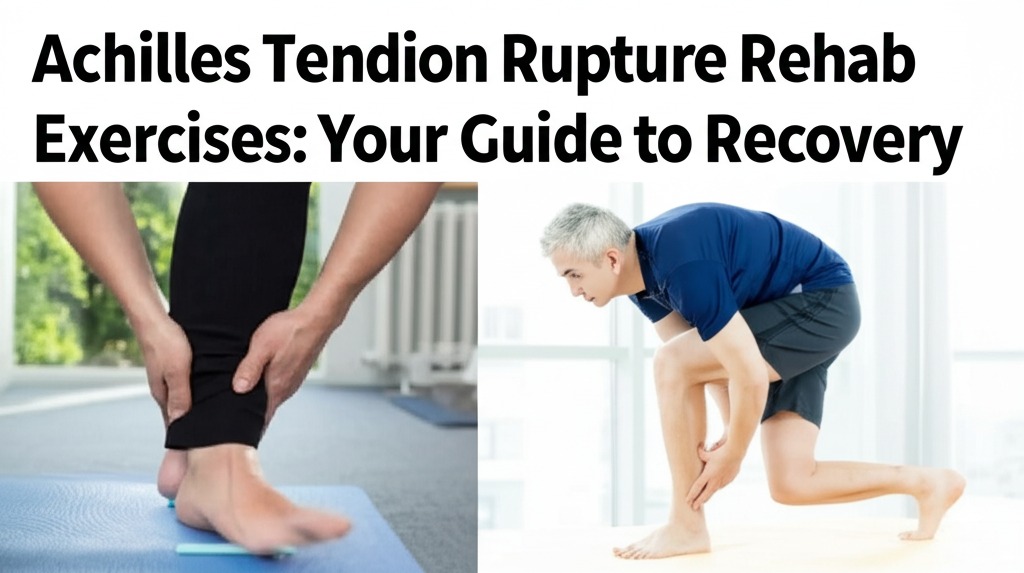Achilles tendon rupture can be a painful and life-altering injury, but with the right rehabilitation exercises, you can return to your active lifestyle. In this article, we’ll explore the essential rehabilitation exercises for Achilles tendon rupture, the timeline for recovery, and tips to accelerate your healing process. Whether you’re an athlete looking to get back on the field or someone working to regain full mobility, this guide will give you the information you need.
Understanding Achilles Tendon Rupture
The Achilles tendon, located at the back of your lower leg, is the largest and strongest tendon in the body. It connects the calf muscles to the heel bone and plays a key role in walking, running, and jumping. A rupture or tear of the Achilles tendon often occurs due to sudden, intense physical activity, such as jumping or sprinting. While surgery can be required in some cases, physical therapy and rehab exercises are crucial for full recovery and preventing re-injury.
The Importance of Rehabilitation
Rehabilitation after an Achilles tendon rupture is a critical part of the healing process. Rehab exercises are designed to:
- Restore range of motion in the ankle and foot.
- Strengthen the calf muscles and surrounding tissues.
- Improve balance and coordination.
- Prevent future injuries.
The rehabilitation process is typically divided into phases, with each phase focusing on specific goals, such as reducing pain and swelling, regaining strength, and eventually returning to normal activity levels.
Phase 1: Early Rehabilitation (0-6 Weeks)
Rest and Initial Mobility
In the first phase of rehab, the focus is on healing and pain management. You’ll likely be in a cast or walking boot to keep your foot immobilized. Your physical therapist may introduce some gentle mobility exercises, which are critical for preventing stiffness.
Key exercises for Phase 1:
- Isometric calf contractions: Sit with your leg outstretched. Gently press your toes into the ground as if trying to point your foot, but without any movement. Hold for 5 seconds and repeat.
- Ankle pumps: While seated, flex and extend your foot slowly, pointing your toes up and down. This helps to reduce swelling and improve circulation.
Rest and Ice
During this phase, don’t rush to jump into intense exercises. Resting and using ice are essential to control inflammation and help manage pain.
Phase 2: Intermediate Rehabilitation (6-12 Weeks)
Gradual Loading and Stretching
Once you’ve progressed past the initial healing phase, your rehabilitation will shift toward gradual loading and stretching exercises. The goal is to restore flexibility, strength, and some weight-bearing capabilities to your leg.
Key exercises for Phase 2:
- Seated heel raises: While seated, place your feet flat on the floor. Raise your heels, engaging your calves, and hold for a few seconds. Lower slowly. This builds strength without putting too much pressure on the tendon.
- Standing calf stretches: Stand facing a wall, with one foot in front of the other. Gently lean forward, stretching the calf of your back leg. Hold for 20-30 seconds, then switch legs.
Strengthening exercises like eccentric calf raises are essential in this phase. They target the tendon in a controlled way, which is key to regaining full strength.
Phase 3: Advanced Rehabilitation (12+ Weeks)
Full-Body Integration and Strength Training
In the advanced phase, you’ll begin more dynamic exercises to rebuild strength and increase mobility. This stage is about preparing for a return to activities like running and jumping.
Key exercises for Phase 3:
- Single-leg calf raises: Stand on one leg and rise up onto your toes. Lower slowly. This helps rebuild strength and coordination in the calf.
- Balance exercises: Use a balance board or stand on one leg to improve stability and proprioception. This is critical for preventing future injuries.
- Agility drills: Once cleared by your physical therapist, start practicing simple agility drills like ladder drills or cone drills to simulate movements in sports.
Stretching and strengthening during this phase ensure that your Achilles tendon is not only healed but also strong enough for the demands of physical activity.
Common Mistakes to Avoid During Rehabilitation
- Overdoing exercises too soon: Progressing too quickly can cause reinjury. Always listen to your body and consult with your physical therapist before pushing yourself.
- Skipping warm-ups and cool-downs: Stretching before and after exercise reduces the risk of strain and helps maintain flexibility in the Achilles tendon.
- Neglecting rest: Rest is just as important as exercise. Proper recovery between workouts ensures that your tendon has time to heal and strengthen.
Tips for Accelerating Your Recovery
- Stay consistent: Consistency is key when it comes to rehab exercises. Stick to your prescribed routine, even when it feels tedious.
- Manage pain effectively: Use ice, elevation, and anti-inflammatory medication as needed. Always follow your doctor’s advice.
- Focus on form: Proper technique in every exercise will minimize the risk of further damage.
- Be patient: Recovery from an Achilles tendon rupture takes time, but with dedication, you’ll gradually see improvements.
Conclusion
Rehabilitating from an Achilles tendon rupture can be a long journey, but with the right exercises and a structured recovery plan, you can return to your regular activities stronger than before. Start slow, stay consistent with your rehab, and gradually challenge yourself as your strength and flexibility improve.
If you’re recovering from an Achilles tendon rupture, make sure to consult a physical therapist for personalized rehab exercises. They will help tailor the exercises to your specific needs, ensuring the best possible recovery.

Kallie Snyder is an author at Stonegate Health Rehab, providing valuable insights, recovery guidance, and rehab resources to help individuals achieve better health and well-being.
